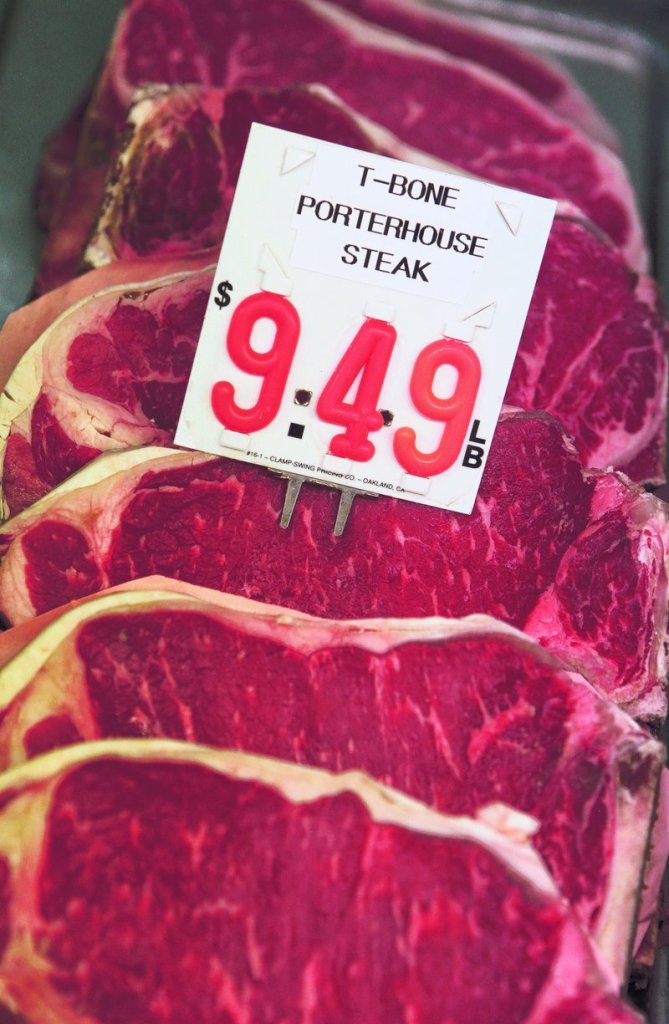LOS ANGELES – American consumers have long enjoyed a luxury that few others around the world could boast: an abundance of affordable food.
But with prices of wheat, corn and other staples soaring, some economists and scientists are wondering how long that can last.
On Wednesday, the Labor Department reported that wholesale food prices jumped 3.9 percent in February over January, the highest monthly increase in 37 years. Economists said they expect to see a similar uptick in what consumers are paying for food at retail when the Labor Department releases its consumer price index today.
“Food prices have been rising a lot faster, because underlying costs have really shot up. You’re seeing some ingredients up 40 percent, 50 percent, 60 percent over last year,” said Ephraim Leibtag, a Department of Agriculture economist. “When you see wheat prices close to 80 percent up, that’s going to ripple out to the public.”
Economists warn that such prices will probably remain high this year and possibly much longer, driven by a confluence of factors: the fall of the U.S. dollar, slowing growth in crop yields, political unrest in the Middle East, high crude oil prices and a revived interest in crop-based biofuels.
Violent weather patterns, which some scientists blame on climate change, are compounding the problem. Recent floods in Australia devastated much of the wheat crop, and a drought threatened China’s crop.
“We’re not sure if these extremes in weather are the new normal,” said Clive James, founder of the not-for-profit International Service for the Acquisition of Agri-Biotech Applications. “But the patterns we’ve seen in the past few years show that this may become more the rule than the exception.”
Some commodity analysts said it is still too early to tell what the broader economic effect will be from the March 11 earthquake, tsunami and growing nuclear crisis in Japan. But they warn that the catastrophes, added to the turmoil in the Middle East and North Africa, could slow the economic recovery in the United States.
They worry that even a temporary boost in grocery bills could have shoppers once again slamming their pocketbooks shut.
U.S. consumers spend only about 10 percent of their annual income on food, yet Americans are already flinching at the gas pumps and at the market checkout stand. The USDA has projected that food prices will rise 3 percent to 4 percent this year.
Produce prices are rising sharply. So is the price of orange juice. This month, PepsiCo said it was raising prices for its Tropicana juices by as much as 8 percent after record cold temperatures chilled this season’s citrus crop in Florida. Rival Coca-Cola Co. had already raised prices on its Minute Maid line.
Some of the biggest increases are expected in the meat section because livestock feed prices have doubled in the past year, Leibtag said. McDonald’s Corp. has warned that it might charge more for Big Macs and other items. Meat producer Smithfield Foods Inc. recently cautioned that consumers will be paying more for bacon, chops and ribs during this summer’s barbecue season.
“Retailers understand there will be more price pressure,” Smithfield Foods Chief Executive C. Larry Pope said during the company’s recent earnings call with analysts.
Before the tragedy in Japan, world food prices had reached a record high this year as stockpiles of key commodities dwindled, according to a price index of 55 food export commodities compiled by the U.N. Food and Agriculture Organization.
Increased demand from China, India and other developing nations is also driving up prices, as a growing middle class is consuming more protein. According to China’s Ministry of Agriculture, urban Chinese increased their consumption of chicken 219 percent from 1983 to 2006.
Elsewhere in the world, where people spend 30 percent to 70 percent or more of their annual income on food, starvation is growing. The World Bank has reported that as many as 44 million more people had been forced into hunger and to miss meals because of the rising costs of food. That, in turn, has fueled the conflict in Libya and helped oust leaders in Tunisia and Egypt.
“The situation is volatile and we’re at a point of transition,” said Abdolreza Abbassian, a grain economist with the Food and Agriculture Organization.
Now, as fears mount of a repeat of food riots around the world in 2007 and 2008, developing new ways to feed people has become more pressing.
For some, the solution is rooted in promoting natural farming techniques and weaning farmers off growing crops for biofuels. A recent U.N. report cited evidence of so-called “agro-ecology” techniques boosting crop yields by 80 percent in 57 developing countries.
Send questions/comments to the editors.



Success. Please wait for the page to reload. If the page does not reload within 5 seconds, please refresh the page.
Enter your email and password to access comments.
Hi, to comment on stories you must . This profile is in addition to your subscription and website login.
Already have a commenting profile? .
Invalid username/password.
Please check your email to confirm and complete your registration.
Only subscribers are eligible to post comments. Please subscribe or login first for digital access. Here’s why.
Use the form below to reset your password. When you've submitted your account email, we will send an email with a reset code.